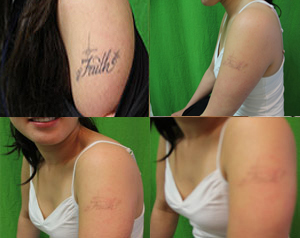Millions of people in the United States get tattoos every year. As of 2010, 23 percent of Americans have a tattoo, according to Pew Research. For those ages 30 to 45, 32 percent have a tattoo. However, many also want to eventually remove tattoos for a number of reasons. This requires laser tattoo removal.
Laser tattoo removal is generally safe with few and usually temporary side effects but those with tattoos over moles and birthmarks should take extra caution before the process. A new study released last month in JAMA Dermatology suggests that getting a tattoo over a birthmark or mole may cause additional problems.

If you desire laser tattoo removal and know that your tattoo is over a mole, have it biopsied before treatment. If you have multiple moles under your tattoo or on other parts of your body, it’s advised that you consult with a dermatologist twice a year.*
Tattoo removal options include excision, dermabrasion and laser. Excision of the tattoo may scar so it’s generally reserved for small tattoos. Dermabrasion “sands” the tattoo on the skin but results are usually minimal. The most common form of tattoo removal is with lasers. “LASER” is an acronym for Light Amplification by Stimulated Emission of Radiation.
This process is known as selective photothermolysis. The laser targets ink but does not damage surrounding skin. The tattoo ink absorbs the laser energy and is absorbed into the body. It is eventually expelled from the body by the immune system.
MOLES AND BIRTHMARKS MAY LEAD TO SKIN CANCER
Unfortunately, getting a tattoo over a birthmark or mole may make it more difficult to detect the development of skin cancer, according to the study. Though people have been getting tattoos for centuries, those who get inked over a birthmark or mole should be cautioned. This is especially important if you are now seeking laser tattoo removal. If you are considering a tattoo, make sure it does not cover any pre-existing birthmarks or moles. Your dermatologist should also track birthmarks and moles for any changes.
The study reveals that researchers in Germany highlight the case of a young man who developed melanoma on a pre-existing colored skin lesion hidden beneath a tattoo during his process of laser tattoo removal. After each laser tattoo removal session, you need to wait at least three weeks for another treatment. The tattoo ink initially broken up needs time be absorbed and removed from the body. The study authors, led by Dr. Laura Pohl of Laserklinik Karlsruhe, also noted that 16 other cases of melanoma have developed within tattoos have been reported in English-language journals.
PRECAUTIONS FOR LASER TATTOO REMOVAL
The researchers advise that no tattoo ink should ever be placed within skin that has a pigmented lesion. If they are, that area should not first be treated with laser tattoo removal.
About half of melanomas develop in pre-existing moles. When skin is covered in tattoos, it’s much more difficult to keep tabs on moles and birthmarks. The tattoo ink hides subtle changes in moles and birthmarks, in which tracking its shape and size is advised on both.
Laser tattoo removal can also complicate underlying issues with birthmarks and moles. Lasers produce pulses of light energy that pass through layers of the skin. How deep they penetrate is dependent upon their nanometer strength. The energy is absorbed by the tattoo, which break the tattoo ink into smaller particles. Eventually the ink is removed from the immune system. At the same time, this process also removes the pigment that the melanoma cells make called melanocytes. If you are developing melanoma, its irregular pigment isn’t detected as easily due to the laser tattoo removal process.
If you desire laser tattoo removal and know that your tattoo is over a mole, have it biopsied before treatment. If you have multiple moles under your tattoo or on other parts of your body, it’s advised that you consult with a dermatologist twice a year. If your dermatologist suspects skin cancer, the skin lesion should be removed prior to laser tattoo removal treatment.
Though tattoos may camouflage birthmarks and moles, there’s no correlation between getting tattoos or tattoo ink that increases your risk for melanoma.
